How to Instantly Cycle a Fish Tank Using Commercial Bacteria
Setting up a new aquarium is thrilling — the shimmering water, the anticipation of vibrant fish gliding through a lush underwater world. But there’s a hidden danger lurking in that crystal-clear tank: toxic ammonia. If you’re eager to add fish right away, waiting four to six weeks for the nitrogen cycle to establish naturally can feel like a cruel delay. Thankfully, modern aquarium science offers a shortcut.
With the right combination of bottled beneficial bacteria and high-quality water conditioners, you can safely “fast-track” the cycling process and create a stable environment in days, not weeks. In this guide, we’ll walk you through exactly how to pull it off — no guesswork, no dead fish, and no regrets. Whether you’re new to the hobby or just impatient to see life in your tank, this is the blueprint you’ve been waiting for.
- Introduction: Why Cycle a Fish Tank
- Solution: Instant Cycling with Commercial Bacteria
- Supply Checklist
- Detailed Steps to Perform Instant Cycling
- Cycle Monitoring
- When to Add Fish
- Tips to Speed Up the Cycling Process
- Warnings! When Using Fish to Cycle
- Conclusion
Introduction: Why Cycle a Fish Tank

Cycling a fish tank refers to establishing the nitrogen cycle, a critical biological process where beneficial bacteria convert toxic ammonia, produced by fish waste and decaying matter, into nitrite, and then into less harmful nitrate. This process is essential for creating a safe and stable environment for fish, as high levels of ammonia or nitrite can cause stress, illness, or even death. Without a proper cycle, fish are at risk of ammonia poisoning or nitrite shock, which can be particularly devastating in newly set up aquariums.
The importance of cycling cannot be overstated, as it ensures water quality remains suitable for aquatic life. In a natural cycle, beneficial bacteria colonize the tank’s filter media, substrate, and surfaces over time, creating a balanced ecosystem.
However, the traditional cycling process can take 3 to 6 weeks, which is a significant hurdle for new aquarists eager to add fish immediately. This delay often leads to frustration, especially for beginners who may not understand the risks of adding fish to an uncycled tank.
The good news is that advancements in aquarium products have made it possible to cycle a tank much faster. By using commercial bacteria and water conditioners, aquarists can establish a functional nitrogen cycle in as little as 24 to 48 hours, bypassing the lengthy waiting period. This method not only saves time but also ensures a safer environment for fish, provided the process is followed correctly. Understanding the need for cycling and the tools available can empower hobbyists to set up their tanks efficiently and responsibly.
Solution: Instant Cycling with Commercial Bacteria
 Seachem Stability Fish Tank Stabilizer #ad
Seachem Stability Fish Tank Stabilizer #ad
Commercial bacteria products, such as API Quick Start, Bio-Spira, Tetra SafeStart, Seachem Stability, or Fritz Zyme 7, contain live or stabilized strains of nitrifying bacteria (Nitrosomonas and Nitrobacter species) that jumpstart the nitrogen cycle. These products introduce the necessary bacteria to convert ammonia to nitrite and nitrite to nitrate, effectively mimicking the natural process in a fraction of the time. When used properly, these products can cycle a tank in 24 to 48 hours, allowing fish to be safely introduced much sooner than with traditional methods.
To achieve instant cycling, the process must be paired with a high-quality water conditioner, such as Seachem Prime, which neutralizes chlorine, chloramine, and heavy metals in tap water while also detoxifying low levels of ammonia and nitrite. This combination ensures the water is safe for both the bacteria and fish from the outset. The key to success lies in following the product instructions precisely, including maintaining proper water temperature (22-28°C) and ensuring adequate oxygenation to support bacterial growth.
The instant cycling method is particularly appealing for aquarists who want to avoid the lengthy wait of a traditional cycle or the risks of fish-in cycling without bacterial aid. However, it requires careful monitoring to confirm the cycle is established, as some products may vary in effectiveness depending on tank conditions. By combining commercial bacteria with a water conditioner, aquarists can create a stable, fish-ready environment quickly, making this approach ideal for both novice and experienced hobbyists seeking efficiency without compromising safety.
Supply Checklist
To successfully cycle a fish tank instantly, you’ll need a few essential items to ensure the process is smooth and effective. First, a fully set-up aquarium is required, including a tank, a reliable filtration system, a heater (if needed for tropical fish), and optional lighting for plant growth or aesthetics. The filter is particularly important, as it provides a surface for beneficial bacteria to colonize, forming the backbone of the nitrogen cycle.
A high-quality water conditioner, such as Seachem Prime #ad or API Stress Coat #ad, is critical to remove chlorine and chloramine from tap water, which can kill both fish and beneficial bacteria. Products like Seachem Prime also temporarily detoxify ammonia and nitrite, offering an extra layer of protection during the cycling process.
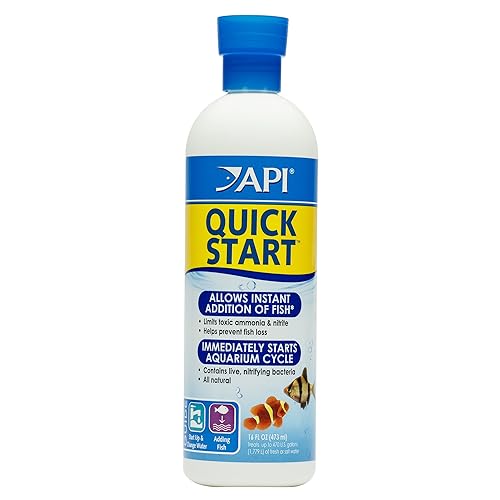 API Quick Start aquarium nitrifying bacteria #ad
API Quick Start aquarium nitrifying bacteria #ad
Additionally, a trusted commercial bacteria product, such as API Quick Start, Fritz Zyme 7, Tetra SafeStart, or Seachem Stability, is essential to introduce live nitrifying bacteria. Choose a product with a good reputation and check its expiration date to ensure viability.
 API Aquarium Test Kit 800 tests #ad
API Aquarium Test Kit 800 tests #ad
A water testing kit that measures ammonia, nitrite, and nitrate levels is non-negotiable for monitoring the cycling process. Kits like the API Freshwater Master Test Kit provide accurate readings to confirm the cycle is complete.
 Ammonium chloride for fishless cycle #ad
Ammonium chloride for fishless cycle #ad
Finally, you’ll need an ammonia source to feed the bacteria, which can be provided in one of three ways: a small number of hardy fish (fish-in cycle, using species like danios or white cloud minnows), pure liquid ammonia (household ammonia without surfactants or additives), or decaying fish food (such as thawed shrimp or fish flakes). Each method has its pros and cons, but all can effectively initiate the nitrogen cycle when paired with commercial bacteria and proper care.
Detailed Steps to Perform Instant Cycling
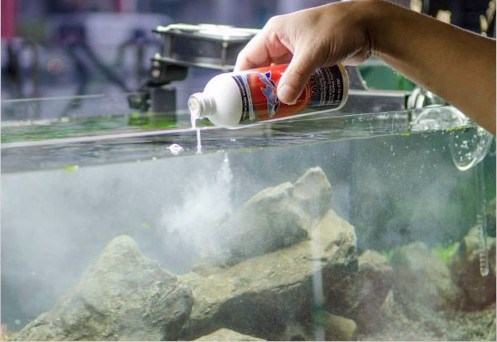
The first step in instantly cycling a fish tank is to completely dechlorinate tap water using a high-quality water conditioner. Chlorine and chloramine, commonly found in tap water, are toxic to both fish and the beneficial bacteria needed for the nitrogen cycle. Follow the product’s dosage instructions carefully, typically adding 1-2 drops per gallon of water, and ensure the water is thoroughly treated before adding any bacteria or fish. This step creates a safe environment for the cycling process to begin.
Next, activate the tank’s filtration system and heater to maintain a stable water temperature between 24-28°C, as this range optimizes the growth of nitrifying bacteria. Ensure the filter is running properly to provide adequate water circulation and oxygenation, which are crucial for bacterial colonization.
If your tank includes a UV sterilizer or ozone generator, turn these off temporarily, as they can kill the live bacteria in commercial products. A stable, warm, and well-oxygenated environment sets the stage for a successful cycle.
Add the commercial bacteria product by shaking the bottle well and pouring the recommended dose directly into the tank and filter, as per the manufacturer’s instructions. Then, introduce an ammonia source to feed the bacteria.
If using a fish-in cycle, add a small number of hardy fish, such as danios or platies, to produce ammonia naturally. Alternatively, dose pure liquid ammonia to achieve 1-2 ppm (test to confirm) or add a small amount of thawed fish food to decompose and generate ammonia. Avoid overfeeding or overdosing, as excessive ammonia can slow the process.
Cycle Monitoring
 API Aquarium Test Kit 800 tests #ad
API Aquarium Test Kit 800 tests #ad
Monitoring the nitrogen cycle is critical to ensure the tank is fully cycled and safe for fish. On days 1-2, expect ammonia levels to rise as the introduced bacteria begin converting it to nitrite. Use a reliable water testing kit, such as the API Freshwater Master Test Kit, to check ammonia levels daily or every other day. By days 2-4, nitrite levels should appear, indicating that the first stage of the cycle (ammonia to nitrite) is active. Continue testing to track the progression of the cycle.
By days 5-7, nitrate levels should begin to increase, while ammonia and nitrite levels drop to zero, signaling a fully established cycle. This timeline may vary slightly depending on the bacteria product, tank conditions, and ammonia source.
If ammonia or nitrite levels remain elevated beyond day 7, perform a partial water change (20-30%) using dechlorinated water and consider adding more bacteria. Testing daily or every other day ensures you catch any issues early and confirm when the tank is ready for additional fish.
Once ammonia and nitrite consistently read 0 ppm and nitrates are detectable (typically 5-20 ppm), the tank is cycled and safe for fish. Regular maintenance, such as partial water changes and filter cleaning, will help maintain the cycle long-term.
By carefully following these steps and monitoring water parameters, aquarists can achieve a fully cycled tank in a fraction of the time compared to traditional methods, ensuring a healthy environment for their aquatic pets.
When to Add Fish

You can safely add fish to the tank once both ammonia and nitrite levels consistently test at 0 ppm, indicating that the nitrogen cycle is fully established. At this stage, nitrate levels should be detectable, typically ranging between 5-40 ppm, as this is the end product of the cycle and less harmful to fish. These readings confirm that the beneficial bacteria are effectively processing waste, creating a stable environment for aquatic life.
To avoid overwhelming the newly established bacterial colony, introduce fish gradually rather than adding the entire stock at once. Start with a small number of hardy fish, such as guppies or tetras, and monitor water parameters for a few days to ensure the cycle remains stable. Overloading the tank can cause ammonia or nitrite spikes, stressing or harming the fish.
If nitrate levels exceed 40 ppm, perform a partial water change (20-30%) with dechlorinated water to bring them down to a safer range before adding more fish. Gradual stocking allows the bacterial population to adjust to the increased bio-load, ensuring long-term stability. Regular testing after adding fish will help you maintain a healthy tank and catch any issues early.
Tips to Speed Up the Cycling Process
To accelerate the cycling process even further, consider adding commercial bacteria daily if the product’s instructions allow, as some brands like Seachem Stability #ad permit multiple doses to boost bacterial populations. Avoid water changes during the cycling process unless absolutely necessary (e.g., ammonia levels exceed 4 ppm), as they can remove beneficial bacteria and slow progress. When maintenance is needed, use dechlorinated water to protect the bacterial colony.
Never rinse filter media or materials in tap water, as chlorine will kill the beneficial bacteria. Instead, gently rinse filter media in tank water during maintenance to preserve the bacterial colony. If you have access to an established aquarium, you can “seed” the new tank with bacteria by transferring a small amount of filter media, substrate, or decorations from the old tank. This introduces an active bacterial population, significantly speeding up the cycle.
Maintaining optimal conditions, such as stable water temperature (24-28°C) and adequate aeration, also promotes faster bacterial growth. Ensure the tank is free of UV sterilizers or chemical treatments that could harm the bacteria. By combining these strategies, you can further reduce the time needed to establish a fully cycled tank, making it ready for fish even sooner.
Warnings! When Using Fish to Cycle
Using fish as an ammonia source (fish-in cycle) carries risks, as elevated ammonia or nitrite levels during the cycling process can stress, harm, or even kill fish. Even with commercial bacteria, temporary spikes in these toxins can occur before the cycle stabilizes. To minimize harm, choose hardy fish species, such as danios, platies, or white cloud minnows, which are more tolerant of fluctuating water conditions.
To further protect fish during a fish-in cycle, dose a water conditioner like Seachem Prime every 24 hours, as it temporarily detoxifies ammonia and nitrite, reducing their toxicity. Follow the product’s instructions carefully to avoid overdosing, which could affect water chemistry. Monitor fish behavior closely for signs of stress, such as gasping, lethargy, or loss of appetite, and be prepared to perform partial water changes if ammonia or nitrite levels rise above 2 ppm.
Whenever possible, opt for a fishless cycle using pure liquid ammonia or decaying fish food, as this eliminates the risk to fish while still providing the ammonia needed to establish the cycle. Fishless cycling is not only safer but also allows for more precise control of ammonia levels, ensuring a smoother and faster process. If you must use fish, proceed with caution and prioritize their well-being through diligent monitoring and water management.
Conclusion
Cycling a fish tank using commercial bacteria and water conditioners is the fastest and most efficient way to establish a safe environment for fish, often completing the nitrogen cycle in just 24-48 hours. This method eliminates the long wait of traditional cycling while maintaining water quality, making it ideal for both beginners and experienced aquarists. By combining commercial products, you can create a stable, fish-ready tank with minimal effort.
However, success depends on careful execution and consistent monitoring. Always test water parameters daily during the cycling process to confirm that ammonia and nitrite drop to 0 ppm and nitrates appear, indicating a complete cycle. Adding fish gradually and maintaining the tank with regular water changes and proper filter care will ensure long-term stability.
Never skip water testing, as it is the key to a healthy, thriving aquarium. A reliable test kit allows you to track the cycle’s progress and catch potential issues before they harm your fish. With the right tools, attention to detail, and a methodical approach, instant cycling can set the foundation for a vibrant, sustainable aquatic ecosystem.

 API Stress Coat #ad
API Stress Coat #ad Seachem Prime #ad
Seachem Prime #ad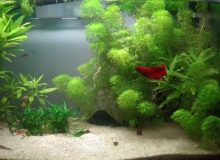
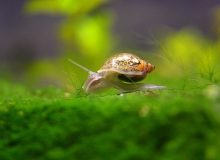
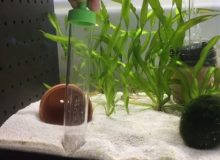

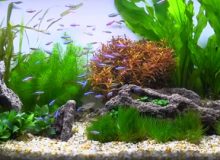
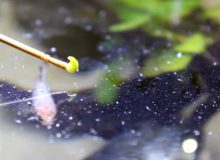
Leave a Reply